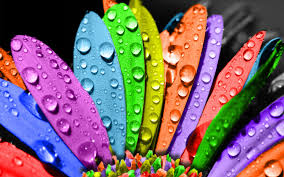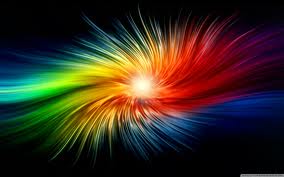Colors, usages & ergonomics

Colors, usages & ergonomics
Human's use their vision as their primary sense for understanding the world around them. While it is true that your other senses can compensate for the lack of sight, in most able body people their vision provides the vast majority of information about their interactions in the world and with people. Large portions of our brain (the visual cortex) are used to interpret the signals from the eye into an understandable picture in the brain. And even more brain power is spent to understand that imagery.
With all this cranial real estate dedicated to vision it should come as no surprise that one of vision's most important aspects, color, plays a major factor in how you feel about certain things. And that connection between color and interpretation is a connection that ergonomics can exploit to make things more intuitive and natural for you.
When we are dealing with ergonomics in this respect we are talking about:
Design communication
Design communication is quite simply how well a design communicates what it is intended to do. For example: when you see a hammer you probably know which end is the handle. Even if you've never seen one before you know which end to grab and then you probably know the other end is used to hit something.
Improving Design Communication with Ergonomics that means the design is communicating the intended use to you so it feels natural to use it that way. Color plays a major factor in good design communication. And, when it is applied appropriately, a little color can go a long way to improving the ergonomics of your design, be it a product or system.
The Basics of Color
When it comes to color you can spend a lifetime studying it. Just ask any artist and they can tell you that the subtle variances in color are each individual and speak of countless different things. We will not be going into that kind of depth about color, but understanding the basics of color theory and the psychological connection people have with color can greatly influence your application of ergonomics.
You interpret color in a rather consistent way. Most people interpret color in a somewhat predictable way. Since the interpretation of color depends on a lot of different factors (lighting, culture, personal temperament, eye sight, etc.) there are no hard and fast rules. But, in general, most people do apply roughly the same meaning and feelings to color.
Your interpretation of color depends on what other colors it is with. This is a basic tenet of color theory and one that is important to remember. Colors are affected by other colors around them. This can affect your perception of size, quality, brilliance and even composition.
For example: a white square on a black background will appear to be larger than a black square of equal size on a white background. Another example: yellow on a white background looks darker and warmer than when it is on a black background. On a black background it looks brighter and colder.
This lays out two important elements of color psychology: the expansiveness of color and the warmth/coldness of color. Another important element of color psychology is color harmony or concordance.
Color harmony can be related directly to its wavelength and the color wheel. For example: red, yellow and blue (the primary colors) work well together. There are many derivatives of harmonious colors and they all give a balance to the color selection that makes them pleasing to the human eye and mind.
We can further define colors by hue, contrast, saturation, luminosity and a number of other factors. But we are not defining colors here; we are instead focusing on how you can use them to improve ergonomics.
One factor that is worth noting is color balance. With all other factors being equal (i.e. saturation, luminosity, etc.) the expansive quality of a color indicates how much is needed to balance with other colors.
What that means is that:
a) There is a direct psychological understanding and cognitive impact of a color
b) The amount of a color used is not always equal
Yellow is the most expansive color. That means a little bit of yellow goes a long way. Compared to violet, yellow is three times more potent. So 1 square of yellow is visually equal to 3 squares of violet. In a practical application this means that painting a small room in yellow might make it feel bigger while painting a large room in violet can make it feel smaller and more intimate. However, at the same time painting a large room yellow, or worse a long hallway, may imbue a since of anxiety in people and cause you to go a bit stir crazy and get aggressive.
That's one of the reason's most office building have taupe walls and gray/blue carpets. These colors are grounded and illicit very minimal reactions from people.
The Psychology of Color
This all laid the ground work for the psychology of color. Yet we have been using color based on its psychological impact for a long time. This gives us a cultural link to color as well. Why does red mean "stop"? Because we use it for stop signs However, we use it for stop signs because red is an alarming color that is correlated to danger.
This is most likely because red is related to dangerous things. It is related to heat and fire, which you do not want to touch. It is related to infection so if your cut is red then you know something is wrong. It is also a color used in nature for a number of poisonous berries and flowers. So as a culture we learned to not eat them and to heed the color red.
So when somebody needed a color to tell people to stop because of danger or for traffic they turned to red.
Green and blue often are safe colors. A green light means go and blue is used for information and calming affects in warning signs. This most likely has some connection to water and vegetable food stuff. Both of which early humans found good so it became part of our collective understanding.
But at the same time these colors have a relative expansiveness. Practically, that means one color will catch your eye more than another. And the amount of immediate attention needed by the thing of that color has a psychological element to it as well.
How We Use Colors
So colors mean something in general to us. And those generalities have been used in cultural application to apply meaning to specific things. For instance your remote control uses color and symbol logy to represent different actions.
Green has become the color for the power button. While red is for record since recording can be a dangerous thing. At least it was back in the days of magnetic tapes where recording meant erasing whatever was on the tape. So we have common ideas about colors and in some scenarios we have specific cultural ideas about colors.Blue is now the color for recycling. But sometimes green is the color of recycling. This is another important lesson in design communication. When one color has an established meaning in a scenario (like a green power button) don't change it unless you are prepared for some confusion.
Colors & ergonomy
Color can greatly influence your ergonomics and your design communication when it applied appropriately. However, it can really mess things up when it is not used in support of our cultural and psychological understanding of color. But when you get it right it can be a game changer.
Colors & hygiene
The red trash bin made it more noticeable and the intent was that it would make you notice throwing away your trash right next to the recycling bin. The red also reinforced it as a negative behavior. All that extra attention paid to the trashing activity by your brain elevates the activity to the forefront of your consciousness so you think about what you are doing instead of just doing it on auto pilot. The result is you stop to separate your trash and recycle what can be recycled and reserve the "bad" red trash can for only those things that can not be reused or recycled.
Sharing in :




